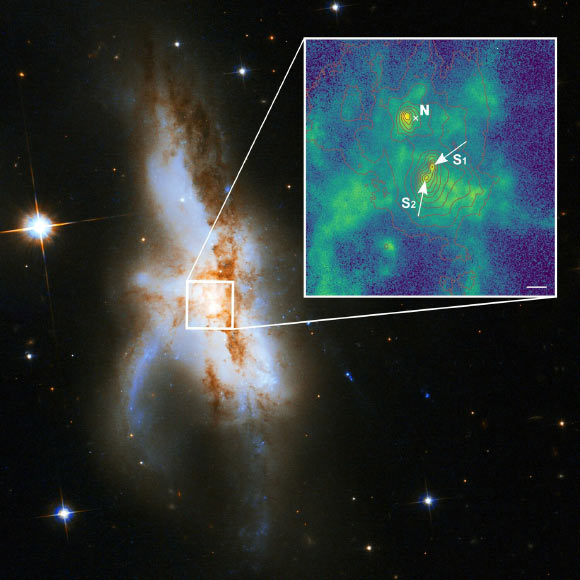Astronomers Find Three Supermassive Black Holes in NGC 6240 | Astronomy – Sci-News.com
NGC 6240, a well-studied nearby galaxy system in the process of merging, contains three supermassive black holes at its core, two of which are active and each with a mass of about 90 million solar masses, according to a study published in the journal Astronomy & Astrophysics.

NGC 6240 harbors three supermassive black holes at its core: the northern black hole (N) is active and was known before; the zoomed-in new high-spatial resolution image shows that the southern component consists of two supermassive black holes (S1 and S2); the green color indicates the distribution of gas ionized by radiation surrounding the black holes; the red lines show the contours of the starlight from the galaxy and the length of the white bar corresponds to 1,000 light years. Image credit: P. Weilbacher, Leibniz Institute for Astrophysics Potsdam / NASA / ESA / Hubble Heritage / STScI / AURA / Hubble Collaboration / A. Evans, University of Virginia, Charlottesville / NRAO / Stony Brook University.
NGC 6240 is a system of merging galaxies approximately 400 million light-years away in the constellation Ophiuchus.
It spans 300,000 light-years and has an elongated shape with branching wisps, loops and tails.
Until now, astronomers have assumed that it was formed by the collision of two galaxies and therefore contains two black holes in its core.
“Through our observations with extremely high spatial resolution we were able to show that NGC 6240 hosts not two but three supermassive black holes in its center,” said Professor Wolfram Kollatschny, an astronomer at the University of Göttingen.
“Each of the three heavyweights has a mass of more than 90 million Suns.”
“They are located in a region of space less than 3,000 light-years across, i.e. in less than one hundredth of the total size of the galaxy.”
Professor Kollatschny and colleagues observed NGC 6240 using the Multi Unit Spectroscopic Explorer (MUSE) instrument on ESO’s Very Large Telescope (VLT).
“Up until now, such a concentration of three supermassive black holes had never been discovered in the Universe,” said Dr. Peter Weilbacher, a researcher in the Leibniz Institute for Astrophysics Potsdam.
“The present case provides evidence of a simultaneous merging process of three galaxies along with their central black holes.”
According to the team, the discovery of the triple supermassive black hole system is of fundamental importance for understanding the evolution of galaxies over time.
“Until now it has not been possible to explain how the largest and most massive galaxies, which we know from our cosmic environment in the ‘present time,’ were formed just by normal galaxy interaction and merging processes over the course of the previous 14 billion years,” the scientists said.
“If, however, simultaneous merging processes of several galaxies took place, then the largest galaxies with their central supermassive black holes were able to evolve much faster. Our observations provide the first indication of this scenario,” Dr. Weilbacher said.
_____
W. Kollatschny et al. 2019. NGC 6240: A triple nucleus system in the advanced or final state of merging. A&A, in press; doi: 10.1051/0004-6361/201936540





